The warmth of Shipibo-Conibo people calmed me. I was welcomed into their world with open arms, smiles and hugs, and I felt a deep sense of belonging from the second I arrived. The community of indigenous people, their kindness and wisdom left a profound impact on me. The Peruvian Amazon Rainforest is home to many indigenous communities. The Shipibo’s have lived in the Amazon for centuries, and their unique culture, tradition, spiritual beliefs and deep connection to the land and its creatures are genuinely remarkable. Here, I began to learn how people can live in perfect harmony with nature. They understand themselves to be part of it, not dominate it, and their respect comes from the knowledge that their own well-being depends on it. They learn from the land, the river and the plants. Nowhere in the world have I met people so spiritual, humble, full of love, able to find pure happiness in the smallest things, constantly laughing and singing. For them, everything in the Universe is constantly singing.
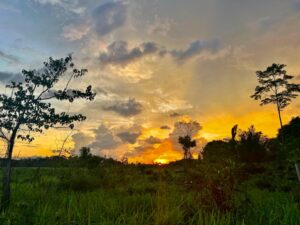
Embracing Simplicity
Upon arrival, they took me to a small wooden hut with a roof covered with palm leaves and windows with mosquito netting and curtains with a recognizable Icaros pattern, adding a touch of culture to the otherwise simple structure. The simplicity of my new home reminded me of the importance of disconnecting from the chaos of modern life and reconnecting with the natural world. From this moment on, I didn’t have access to the internet. I was left with my notebooks, pen, my own thoughts and sounds of the jungle that are constantly changing throughout the day – from the chirping of exotic birds in the morning, playful monkeys and the buzzing of insects in the afternoon to the mysterious calls of nocturnal animals taking over the forest.
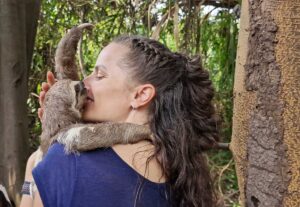
Amazonian villages are usually nestled in a less thick part of the rainforest for easier access to resources such as food, water, and materials for building and crafting. This also allows the creation of clearings for agriculture, provides a degree of protection from predators, and allows a greater sense of safety.
The Hidden Treasures of the Jungle
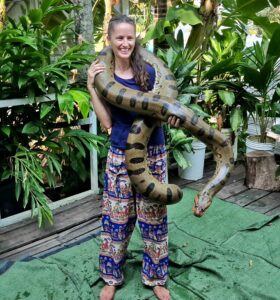
From the moment I arrived, I heard the song of the Great Amazon Rainforest calling me to dive more profoundly into its green depths, explore its natural wonders with all my senses and feel its power and vastness. I knew that, despite its beauty, it was a harsh and unforgiving environment that I shouldn’t explore alone. At least not the first time. The next day I was accompanied on my first of many walks. As we ventured deeper, I could feel the spirit of the rainforest enveloping me. It was more than just sound. It was a vibration that touched my soul.
I marvelled at the intricate web of life and the variety of plants that surrounded me, feeling a deep sense of interconnectedness with every living thing. The rainforest was alive and pulsing with energy, and I could feel it flowing through me, filling me with a sense of awe and veneration. I was privileged to learn about the tallest trees I’ve ever seen and different plants used for medical and ceremonial purposes that I later had the honour to prepare with them. A stream with crystal clear water crossed our path, and they showed me how water can be drunk on the spot. Every corner of the jungle seemed to be bursting with life. Sloths and monkeys were hanging from the treetops, anteaters hiding between the trees searching for the ants that had created a whole parallel world with their meter-high towers of anthills and an incredibly complex interwoven network of paths on the ground. The air was thick with the scent of tropical blooms.
From Green to Ash
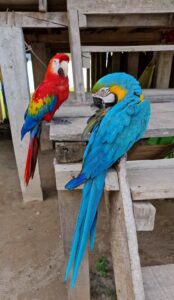
Suddenly, I was struck by a devastating site. The vibrant and lush forest turned into a charred wasteland of ash and destroyed trees. A month before my arrival, someone had set a fire that burnt more than 80 km2 of the rainforest. It was an overwhelming scene to witness. They told me how they fought the raging fire for weeks. As they don’t have access to fire departments or modern firefighting equipment, they were battling the flames with their bare hands, buckets, and shovels to protect their homes and communities.
The story about the deforestation of the Amazon is very well known worldwide. Large-scale development projects, such as logging, farming, and mining, are encroaching on their territories and destroying their forests and rivers. Indigenous people fight for their rights, the protection of their forests and the preservation of their culture for future generations. The awareness of the consequences, right there on the spot, gave me chills. I couldn’t help but wonder how is it even possible that we’re witnessing these scenes today with all the knowledge about the loss of biodiversity, extinction of many species, and climate change on a global level that is destroying humankind.
Awakening the Healer Within
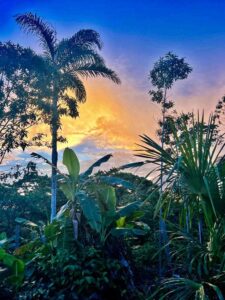
I spent a decent part of my days in my peaceful cottage, writing, reading, meditating, and reflecting on my life and why I set out on this adventure. In a short period, life confronted me with a huge loss and tough situations, one after another. The stress of it all had taken a toll on my body, and deep down I knew I had to take control of my healing. I’ve often heard about the transformative power of plant medicine in the Amazon rainforest. Finally, after a lot of research and conversations with experienced individuals, I was brave enough to embark on the most extreme and expensive journey of my life, unsure of what lays ahead but determined to push through my fear.
Indigenous people believe that plants hold the wisdom and knowledge of the Universe and that by consuming them in a specific way, we can tap into this knowledge and gain a deeper understanding of ourselves and the world around us. For the Shipibo’s, fasting and dieting with the plant spirits in seclusion is the most direct way to learn and heal. They’ve passed down their knowledge and relationship with plants for thousands of years through deeply personal diets. It’s a sacred and powerful tradition that I feel incredibly grateful to have experienced. Not everyone endures these diets, as they are incredibly physically and emotionally challenging, especially in terms of renunciation, but the rewards are immense for those who complete them. I surrendered to “La Dieta” process through purifications, purging, plant bathing, smudging, “rapés”, and their powerful ceremonies with Kambo and Sacred Plant Medicine, connecting deeply with the highly intelligent and wise spirits of nature that led me to transformative healing and self-discovery.
A journey into the unknown
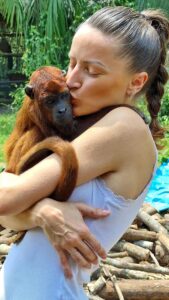
The healing ceremonies are led by the Shaman (healer), the community’s spiritual leader, inside the Maloca. This traditional and sacred communal house represents the centre of indigenous cosmology. It’s believed to be the dwelling place of the spirits of nature, the physical representation of the interconnectedness of all life forms in the Amazon rainforest. In the central area is the altar adorned with offerings of Amazonian tobacco and other sacred plants, crystals, and other objects that hold spiritual meaning. The altar represents a connection between the physical and spiritual worlds and serves as a portal for communication with the spirits and energies that inhabit the rainforest.
If I hadn’t witnessed it myself, I would never be able to understand shamans’ ethereal power, which enables them to communicate with spirits, diagnose and treat a wide range of ailments, and access hidden knowledge about the Universe. They can sense the energy and emotions of those around them and are able to access information about a person’s past, present, and future through their connection to the divine. It is, by far, the most extraordinary thing I’ve ever lived through in my entire life. Testimony to the sacredness, profoundness and power of those ceremonies is written on 250 pages in my diaries which will hopefully once see the light of day.
The Melody of Belonging
An essential part of the ceremonies are Icaros – songs that are believed to be the language of the plants, songs unlike anything I had ever heard. They help to guide the shamans and the participants on a journey of healing and self-discovery. Through Icaros, the Shaman can communicate with the plants and ask for their guidance and healing powers. The haunting melodies and intricate rhythms of Icaros transported me to another world, and I felt a immense reverence for their spirituality.
Icaros are not only the sacred tool of connection to the spiritual world but also a fundamental part of their identity, deeply rooted in their culture and reflected in everything they do, including their architecture and art. I was overwhelmed with the beauty of the hand embroidery and hand-painted ceramic pots they had crafted. Every pattern is a different note and verse, and they can read and sing it. For us, who don’t, it is like witnessing some imaginary parallel world.
Ancient Wisdom, Modern World
The truth is, in the heart of the Amazon rainforest, there is a world few outsiders have ever seen. A world of incredible beauty and wonder, of lush greenery and exotic wildlife. And it is also a world of people that have lived in harmony with the land for generations. These communities are like something out of a fairy tale.
As I learned about their way of life, traditions, and culture, I can’t help but compare them to the Na’vi people from the Avatar movie. These communities are fighting to protect their land and way of life from outside forces threatening to destroy them. They have a deep and profound connection to the natural and spiritual world, unlike anything I knew existed. The world that changed me and healed me on so many levels.
My journey to the Amazon rainforest was a powerful lesson of the incredible wisdom and knowledge that can be found in the most unlikely places. We, Westerners, think of ourselves as advanced and superior. But the truth is very much different. Indigenous communities have much to teach us about what it means to be human and the importance of living in harmony with the earth and our own soul. And as we continue to navigate the challenges of the modern world, let’s never forget how in fact fragile we are and how much responsibility we have to create a better future for ourselves and our precious planet.